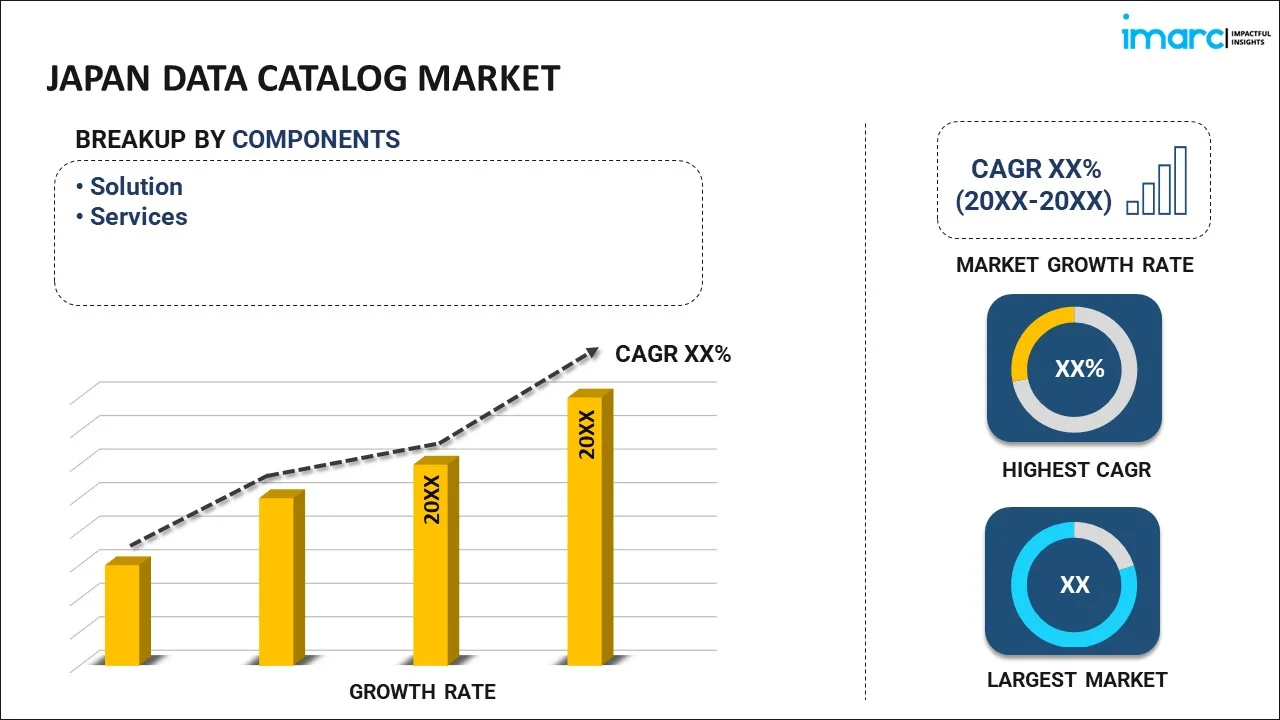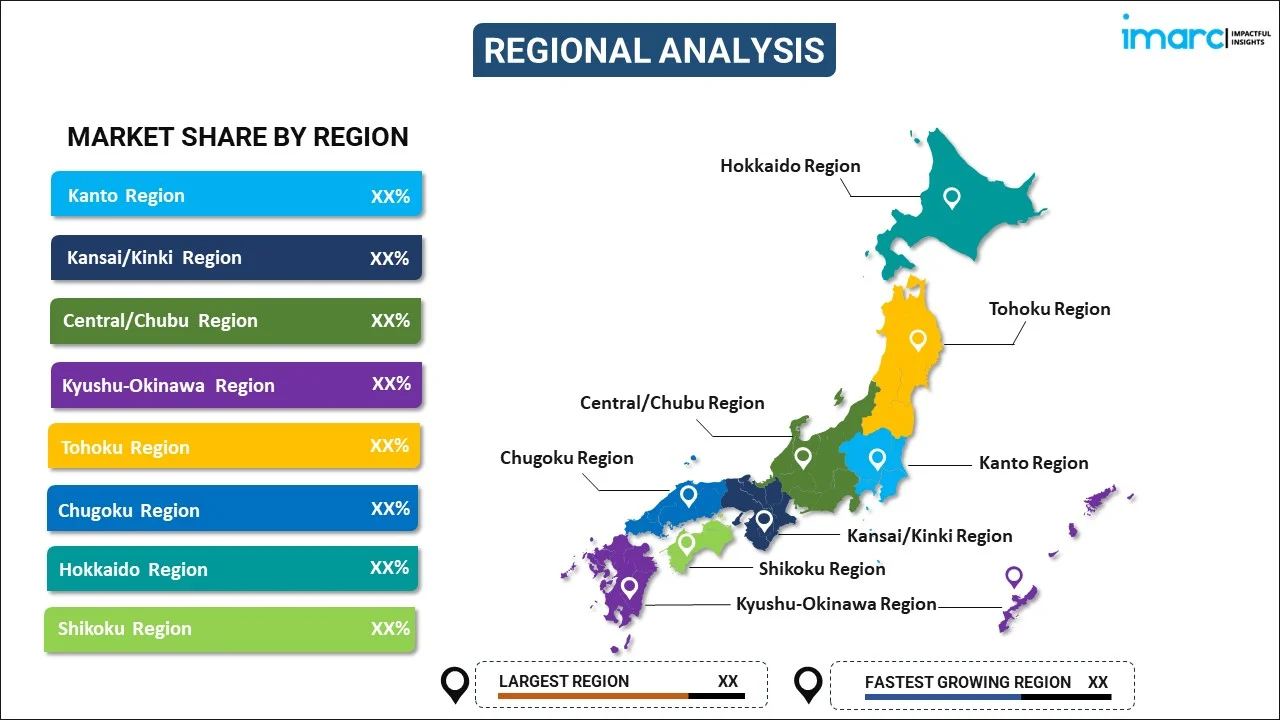
Japan Data Catalog Market Report by Component (Solution, Services), Deployment Mode (On-premises, Cloud-based), Organization Size (Small and Medium-sized Enterprises, Large Enterprises), Data Consumer (Business Intelligence Tools, Enterprise Applications, Mobile and Web Applications), End Use Industry (BFSI, Retail and E-Commerce, Manufacturing, Government and Defense, Energy and Utilities, IT and Telecom, Education, Healthcare, and Others), and Region 2025-2033
Market Overview:
Japan data catalog market size is projected to exhibit a growth rate (CAGR) of 16.8% during 2025-2033. The widespread adoption of business intelligence tools is encouraging organizations to extensively invest in the deployment of data catalog solutions, which is primarily driving the market growth.
|
Report Attribute
|
Key Statistics
|
|---|---|
|
Base Year
|
2024 |
|
Forecast Years
|
2025-2033 |
|
Historical Years
|
2019-2024
|
| Market Growth Rate (2025-2033) | 16.8% |
A data catalog is a resource that various businesses employ to house a wide array of data assets, encompassing databases, web content, and output files. Its primary function lies in enabling businesses to efficiently navigate and oversee substantial data volumes, thereby enhancing data accessibility for users. In the realm of contemporary data management, it serves as an indispensable tool frequently utilized as a reference platform by data users. Consequently, it aids users in comprehending data and facilitates the search for valuable insights crucial for informed decision-making. Across sectors such as healthcare, manufacturing, and e-commerce, the utilization of data catalogs is extensive, aimed at dismantling data silos, eliminating redundancy, and streamlining the process of uncovering valuable data.
Japan Data Catalog Market Trends:
The Japan data catalog market is significantly influenced by trends similar to the global market. Foremost among these is the substantial growth witnessed in the information technology (IT) industry. Concurrently, there is a rapid digitization wave sweeping across multiple sectors in Japan, leading to a significant surge in data generation. This surge has prompted numerous organizations to make substantial investments in the adoption of data catalog solutions, thus fueling market growth in the country. Additionally, ongoing technological advancements within the corporate landscape are contributing to a positive market outlook on a global scale. Notably, the widespread integration of cloud-based technologies with data catalogs, aimed at facilitating the creation of personalized data for data analysts, is exerting a favorable influence on market expansion in Japan as well. Furthermore, the outbreak of the coronavirus disease (COVID-19) globally has prompted many businesses in Japan to adopt the work-from-home (WFH) approach. This shift has provided added momentum to the growth of the data catalog market in the country.
Other factors contributing to market expansion in Japan include ongoing enhancements within the manufacturing and e-commerce sectors and increased investments in extensive research and development (R&D) activities. These elements collectively drive the data catalog market in Japan over the forecasted period.
Japan Data Catalog Market Segmentation:
IMARC Group provides an analysis of the key trends in each segment of the market, along with forecasts at the country level for 2025-2033. Our report has categorized the market based on component, deployment mode, organization size, data consumer, and end use industry.
Component Insights:

- Solution
- Services
The report has provided a detailed breakup and analysis of the market based on the component. This includes solution and services.
Deployment Mode Insights:
- On-premises
- Cloud-based
A detailed breakup and analysis of the market based on the deployment mode have also been provided in the report. This includes on-premises and cloud-based.
Organization Size Insights:
- Small and Medium-sized Enterprises
- Large Enterprises
The report has provided a detailed breakup and analysis of the market based on the organization size. This includes small and medium-sized enterprises and large enterprises.
Data Consumer Insights:
- Business Intelligence Tools
- Enterprise Applications
- Mobile and Web Applications
A detailed breakup and analysis of the market based on the data consumer have also been provided in the report. This includes business intelligence tools, enterprise applications, and mobile and web applications.
End Use Industry Insights:
- BFSI
- Retail and E-Commerce
- Manufacturing
- Government and Defense
- Energy and Utilities
- IT and Telecom
- Education
- Healthcare
- Others
The report has provided a detailed breakup and analysis of the market based on the End use industry. This includes BFSI, retail and e-commerce, manufacturing, government and defense, energy and utilities, IT and telecom, education, healthcare, and others.
Regional Insights:

- Kanto Region
- Kansai/Kinki Region
- Central/ Chubu Region
- Kyushu-Okinawa Region
- Tohoku Region
- Chugoku Region
- Hokkaido Region
- Shikoku Region
The report has also provided a comprehensive analysis of all the major regional markets, which include Kanto Region, Kansai/Kinki Region, Central/ Chubu Region, Kyushu-Okinawa Region, Tohoku Region, Chugoku Region, Hokkaido Region, and Shikoku Region.
Competitive Landscape:
The market research report has also provided a comprehensive analysis of the competitive landscape. Competitive analysis such as market structure, key player positioning, top winning strategies, competitive dashboard, and company evaluation quadrant has been covered in the report. Also, detailed profiles of all major companies have been provided.
Japan Data Catalog Market Report Coverage:
| Report Features | Details |
|---|---|
| Base Year of the Analysis | 2024 |
| Historical Period | 2019-2024 |
| Forecast Period | 2025-2033 |
| Units | Million USD |
| Scope of the Report | Exploration of Historical Trends and Market Outlook, Industry Catalysts and Challenges, Segment-Wise Historical and Future Market Assessment:
|
| Components Covered | Solution, Services |
| Deployment Modes Covered | On-premises, Cloud-based |
| Organization Sizes Covered | Small and Medium-sized Enterprises, Large Enterprises |
| Data Consumers Covered | Business Intelligence Tools, Enterprise Applications, Mobile and Web Applications |
| End Use Industries Covered | BFSI, Retail and E-Commerce, Manufacturing, Government and Defense, Energy and Utilities, IT and Telecom, Education, Healthcare, Others |
| Regions Covered | Kanto Region, Kansai/Kinki Region, Central/ Chubu Region, Kyushu-Okinawa Region, Tohoku Region, Chugoku Region, Hokkaido Region, Shikoku Region |
| Customization Scope | 10% Free Customization |
| Post-Sale Analyst Support | 10-12 Weeks |
| Delivery Format | PDF and Excel through Email (We can also provide the editable version of the report in PPT/Word format on special request) |
Key Questions Answered in This Report:
- How has the Japan data catalog market performed so far and how will it perform in the coming years?
- What has been the impact of COVID-19 on the Japan data catalog market?
- What is the breakup of the Japan data catalog market on the basis of component?
- What is the breakup of the Japan data catalog market on the basis of deployment mode?
- What is the breakup of the Japan data catalog market on the basis of organization size?
- What is the breakup of the Japan data catalog market on the basis of data consumer?
- What is the breakup of the Japan data catalog market on the basis of end use industry?
- What are the various stages in the value chain of the Japan data catalog market?
- What are the key driving factors and challenges in the Japan data catalog?
- What is the structure of the Japan data catalog market and who are the key players?
- What is the degree of competition in the Japan data catalog market?
Key Benefits for Stakeholders:
- IMARC’s industry report offers a comprehensive quantitative analysis of various market segments, historical and current market trends, market forecasts, and dynamics of the Japan data catalog market from 2019-2033.
- The research report provides the latest information on the market drivers, challenges, and opportunities in the Japan data catalog market.
- Porter's five forces analysis assist stakeholders in assessing the impact of new entrants, competitive rivalry, supplier power, buyer power, and the threat of substitution. It helps stakeholders to analyze the level of competition within the Japan data catalog industry and its attractiveness.
- Competitive landscape allows stakeholders to understand their competitive environment and provides an insight into the current positions of key players in the market.
Need more help?
- Speak to our experienced analysts for insights on the current market scenarios.
- Include additional segments and countries to customize the report as per your requirement.
- Gain an unparalleled competitive advantage in your domain by understanding how to utilize the report and positively impacting your operations and revenue.
- For further assistance, please connect with our analysts.
 Inquire Before Buying
Inquire Before Buying
 Speak to an Analyst
Speak to an Analyst
 Request Brochure
Request Brochure
 Request Customization
Request Customization




.webp)




.webp)












